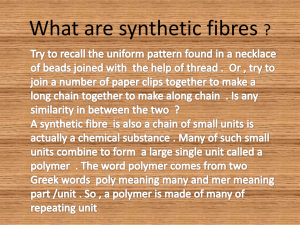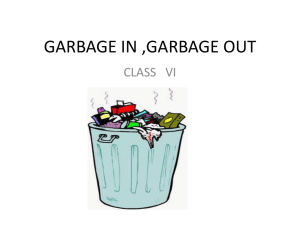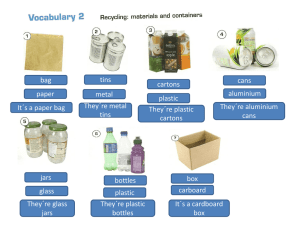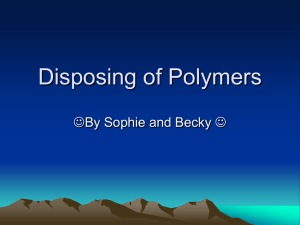- The Institution of Engineers of Kenya
advertisement
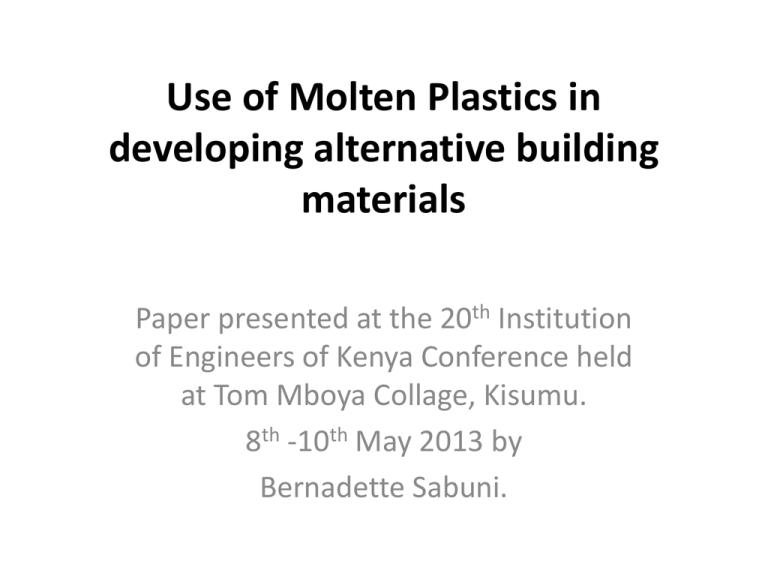
Use of Molten Plastics in developing alternative building materials Paper presented at the 20th Institution of Engineers of Kenya Conference held at Tom Mboya Collage, Kisumu. 8th -10th May 2013 by Bernadette Sabuni. Use of Molten Plastics in developing alternative building materials Paper presented at the 20th Engineers’ International Conference held at Tom Mboya Labour College Kisumu. 8th -10th May 2013 by Bernadette Sabuni. 1.0 Introduction • Plastic manufacturing is a multi-million dollar industry. However, disposal of these plastics after use pose environmental problems. • Plastics in different forms are found in all municipal solid waste. • It is a common sight in both urban and rural areas to find empty plastic bags and type of plastic packing material littering the environment • Due to its biodegradability it creates stagnation in water and associated hygiene problems Introduction Cont. • It has been shown that plastics, when added to hot aggregate will form a fine coat of plastic over the aggregate thus improving conditions of bonding. • The composite material is found to have higher strength, higher resistance to water absorption and better performance over a period of time. 2.0 Materials • This research project sought to determine the properties of samples made using molten plastics and quarry dust. • Waste plastics were in the class of thermoplastics collected within the university environment. • Quarry dust was obtained from stock piles at the university construction site. 2.1 Plastic Wastes 2.2 Quarry Dust 3.0 Method • Samples were made by casting of the molten plastic-quarry dust mix in cylindrical moulds obtained by cutting steel tube 150mm height and 105mm diameter. • The were then immersed in water for 24 hours before testing. 3.1 Melting of the Plastics 3.2 Mixing 3.4 Homogeneous Mix 3.5 Placing and Compaction of the Mixture 3.6 Curing of Samples 4.0 Results • As percent plastic increases, the density decreases proportionally. • Water absorption decreases non- linearly as the % of plastic increases. The decrease of water absorption with increase in plastic matrix may be attributed to the water repelling properties associated with plastics. • the strength increases gradually and then exponentially from the first plot up to a value of 10.50 N/mm², then decreases with further increase in plastic proportion 4.1 Density 4.2 Water Absorption 4.3 Compressive Strength 5.0 Conclusion • From the study it is evident that blocks made using waste plastic binder and quarry dust in an optimum mix proportion can meet the strength requirement for load bearing (>5.0 N/mm²) walls. • The resulting composite material has water repelling properties. 6.0 Recommendations • There is need to test the blocks at different temperatures to establish the behavior exhibited • Since blocks made from this material may not be joined using cement mortar an alternative approach is required e.g. the mortarless interlocking blocks • This concept can be improved to make it feasible in a factory setting for instance a hydram machine can be modified to make such blocks. 7.0 Challenges • Temperature regulation was very critical in this exercise not only to avoid complete combustion of plastics but also to allow mixing, placing and compaction of the samples. • It was noted that a temperature drop below the melting range could caused plastic set before moulding. • The fumes from melting plastic and the high operating temperatures posed a risk to health. • Also manual mixing posed difficulties in achieving consistency of molten plastic – quarry dust mix. Thank You for Listening Comments, questions, suggestions?




